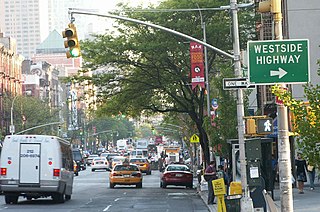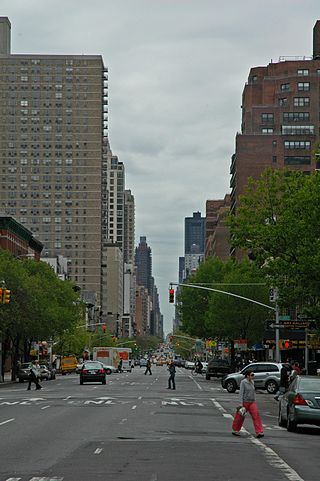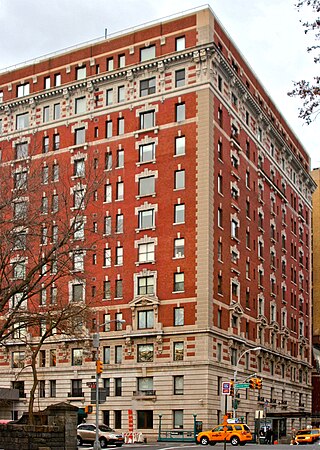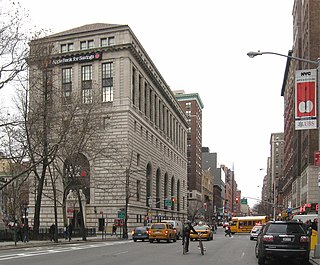
The Upper West Side (UWS) is a neighborhood in the borough of Manhattan in New York City. It is bounded by Central Park on the east, the Hudson River on the west, West 59th Street to the south, and West 110th Street to the north. The Upper West Side is adjacent to the neighborhoods of Hell's Kitchen to the south, Columbus Circle to the southeast, and Morningside Heights to the north.

Ninth Avenue, known as Columbus Avenue between West 59th and 110th Streets, is a thoroughfare on the West Side of Manhattan in New York City, United States. Traffic runs downtown (southbound) from the Upper West Side to Chelsea. Two short sections of Ninth Avenue also exist in the Inwood neighborhood, carrying two-way traffic.

86th Street is a major two-way street in the Upper East Side and Upper West Side of the New York City borough of Manhattan. It runs in two major sections: between East End and Fifth Avenue on the Upper East Side, and between Central Park West and Riverside Drive on the Upper West Side. The western segment feeds into the 86th Street transverse across Central Park, which connects to East 84th and 85th Streets on the eastern side.

The Ansonia is a condominium building at 2109 Broadway, between 73rd and 74th Streets, on the Upper West Side of Manhattan in New York City. The 17-story structure was designed by French architect Paul Emile Duboy in the Beaux-Arts style. It was built between 1899 and 1903 as a residential hotel by William Earle Dodge Stokes, who named it after his grandfather, the industrialist Anson Greene Phelps. Over the years, the Ansonia has housed many conductors, opera singers, baseball players, and other famous and wealthy people. The Ansonia is a New York City designated landmark and is listed on the National Register of Historic Places.

The 86th Street station is a local station on the IRT Broadway–Seventh Avenue Line of the New York City Subway. Located at the intersection of West 86th Street and Broadway on the Upper West Side of Manhattan, it is served by the 1 train at all times and the 2 train during late nights.

85th Street is a westbound-running street, running from East End Avenue to Riverside Drive in the borough of Manhattan in New York City, United States.
The Dauphin Hotel was an establishment located on the west block front of Broadway between 66th Street and 67th Street. In 1958, the ballroom of the hotel was behind Julia Murphy's Bar. The Dauphin Hotel was demolished as part of the excavation for the Lincoln Center for the Performing Arts. By 1964, the site was taken by the Empire Mutual Insurance Group building. This edifice also occupied the space where the Marie Antoinette Hotel previously stood. The area is currently occupied by a variety of retail stores including Raymour & Flanigan, Zara, and Pottery Barn, as well as a residential building.

The Marbridge Building is an office building at 1328 Broadway, on the east side of Sixth Avenue between 34th and 35th Streets in Herald Square, Manhattan, New York City. It opened in 1909, an 11-story structure, utilized in part by men's clothier Rogers Peet. Until October 1910 it stood opposite the Alpine apartment house, which was at the northeast corner of Broadway and 33rd Street. The Alpine and old stores between 33rd and 34th Streets were demolished to make room for the $5,000,000 Hotel McAlpin near the end of 1910. On the other side of Broadway were located the Macy's Herald Square and Saks Incorporated stores, with the Gimbels store just below.
The Studebaker Building is a former structure at 1600 Broadway on the northeast corner at 48th Street in Manhattan, New York City. It was erected by the Juilliard Estate, in 1902, between Broadway and 7th Avenue, in the area north of Times Square. It was demolished in 2004 to make room for an apartment tower, a twenty- five story, 136 unit, luxury condominium designed by architect Einhorn Yaffee Prescott.
The Gunther Building was a seven-story commercial edifice in Manhattan located at 391 - 393 Fifth Avenue, between 36th Street and 37th Street. It occupied a plot 41.8 feet (12.7 m) on Fifth Avenue by 111.8 feet (34.1 m) in depth. Built in 1909, the establishment conformed in architecture, appointments, and construction with the Tiffany and Company Building, which adjoined it. The latter structure was designed by Stanford White and was constructed by Tiffany & Company in 1903, at the corner of the block on 37th Street.

The Belnord is a condominium building at 225 West 86th Street on the Upper West Side of Manhattan in New York City. The 13-story structure was designed by Hiss and Weekes in the Italian Renaissance Revival style and occupies the full block between Broadway, Amsterdam Avenue, and 86th and 87th Streets. It was built between 1908 and 1909 by a syndicate of investors as a rental apartment building. The Belnord is a New York City designated landmark and is listed on the National Register of Historic Places.

257 Central Park West is a co-op apartment building on the southwest corner of 86th Street and Central Park West in the Upper West Side of Manhattan in New York City. It was designed by the firm of Mulliken and Moeller and built by Gotham Building & Construction between 1905 and 1906.

Rossleigh Court, constructed between 1906 and 1907, currently is a rental apartment building located on the northwest corner of 85th Street and Central Park West in the Upper West Side of Manhattan in New York City.
Harry B. Mulliken was an early twentieth-century American architect and developer who built many of his works in New York City. Mulliken's apartment and hotel buildings are remarkable for their Beaux-Arts-style and broad use of architectural terra cotta set around flat, and often red, brick.
Edgar Joachim Moeller was an early twentieth-century American architect who partnered with Harry Mulliken to build several apartment hotels in New York City. The partnership's Beaux-Arts style is distinguishable and makes a similarly broad use of architectural terra cotta set around flat brick.

The Pabst Hotel occupied the north side of 42nd Street in Manhattan, New York City, between 7th Avenue and Broadway, in Longacre Square, from 1899 to 1902. It was demolished to make room for the new headquarters of The New York Times, for which Longacre Square was renamed Times Square.

390 Fifth Avenue, also known as the Gorham Building, is an Italian Renaissance Revival palazzo-style building at Fifth Avenue and West 36th Street in the Midtown Manhattan neighborhood of New York City, United States. It was designed by McKim, Mead & White, with Stanford White as the partner in charge, and built in 1904–1906. The building was named for the Gorham Manufacturing Company, a major manufacturer of sterling and silverplate, and was a successor to the former Gorham Manufacturing Company Building at 889 Broadway. The building features bronze ornamentation and a copper cornice.

The Apple Bank Building, also known as the Central Savings Bank Building and 2100 Broadway, is a bank and residential building at 2100–2114 Broadway on the Upper West Side of Manhattan in New York City, New York, United States. Constructed as a branch of the Central Savings Bank from 1926 to 1928, it occupies a trapezoidal city block bounded by 73rd Street to the south, Amsterdam Avenue to the east, 74th Street to the north, and Broadway to the west. The Apple Bank Building was designed by York and Sawyer in the Renaissance Revival and palazzo styles, patterned after an Italian Renaissance-style palazzo.
















